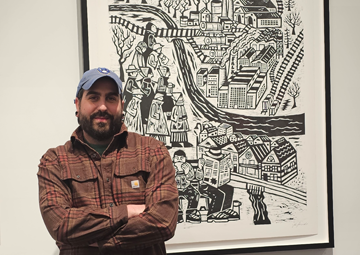
The Labor Movement: The story of Milwaukee’s industrial past
Milwaukee has, for over a century, been a destination for innovation and industry, but as local artist John Fleissner will tell you, Milwaukee was once called the “Machine Shop of the World.”
Touring Milwaukee today, remnants of its industrial past are trickled throughout the area. It was this often-overlooked history of workers who populated and built this city that Fleissner wanted to capture in his woodcut series, A Map of Working Class Milwaukee.
Every detail, big and small, tells a story. In the print highlighting Milwaukee’s brewing roots, Fleissner features women’s role as bottle workers in the 1800s, a difficult job at the time. In the print showcasing the former Allis-Chalmers plant, Fleissner presents workers manufacturing a tractor at what was once one of the world’s greatest agricultural machinery producers. And the print of the Menomonee River Valley features workers flooding the valley once lined with massive industrial operations such as Miller Brewing Company, the Milwaukee Road and Falk Corporation.
“If you go around Milwaukee today, you’ll see the shell of the industries that used to be here,” Fleissner said. “I wanted to explore that history, not necessarily from a single time period, but encapsulating the general Modernist era to represent the working class that made Milwaukee and have people interact with that history.”
Fleissner has produced works of art professionally since 2012. Despite experience in various types of media like painting and murals, his primary source of artistic passion stems from reliefs, carving what he calls “giant stamps” out of linoleum and wood.
The printmaking process is laborious. The idea must go from artwork, to carving out that vision, to applying ink and printing. It’s a demanding undertaking Fleissner finds fitting for paying homage to the labor movement, something his work has heavily focused on in his career.
A student of the printmaking process, Fleissner said this medium’s history has long been used to express ideas about what’s going on in the world today. When he was commissioned to create works for the We Energies Foundation Art Collection, he brought the industrial tales he’s heard to life.
“I’m a huge nerd for Milwaukee, labor and industrial history,” Fleissner said. “It’s really cool to get to represent the city’s story for people who might come here from other places. From big industry events to public schools taking a tour, it’s incredible to share something people might not know about Milwaukee history.”
Each print was a time-consuming task. Carving out the woodcuts took a total of about 40 hours. Then came the printing process. This required setting up the ink press, applying the ink across the woodcut and finally running it through the press. Using this more traditional approach, each print took about a full-day’s work to complete.
Now framed and on display in Baird Center, Fleissner said this work has inspired him create more works that tell stories as commemorations of lesser-known histories and place them in locations both people from the local area and visitors will be able to experience and learn from.
“The art in Baird Center is not what you see normally in a convention center,” Fleissner said. “They really let the artists share their visions and you see that with all of the unique pieces hanging in there today. I think it’s great for local artists to have their work, truly their work, hanging in a high-visible public space like this.”
A Map of Working Class Milwaukee is part of the We Energies Foundation Art Collection located at Baird Center. John Fleissner is one of the thirty-three artists, most from Milwaukee, Wisconsin or with special ties to the area who have works featured in the collection. You can discover more about the artists and their works at https://bairdcenter.com/art-collection/.